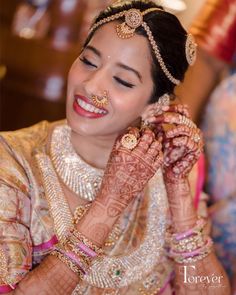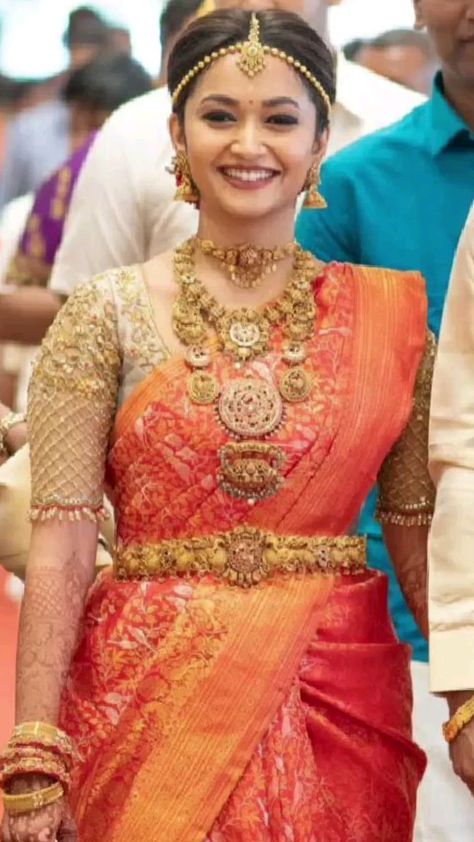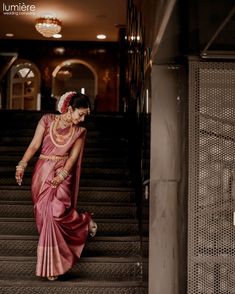South Indian Jain Bridal
The South Indian Jain community is renowned for its rich cultural heritage and traditional customs, particularly when it comes to weddings. Jain weddings are marked by their simplicity, elegance, and adherence to age-old rituals. Within the South Indian Jain community, the bridal tradition holds a special significance, blending elements of spirituality, tradition, and modernity. In this class note, we delve into the intricacies of the South Indian Jain bridal tradition, exploring its unique rituals, attire, jewelry, and customs.

Rituals and Ceremonies: A South Indian Jain bridal ceremony is a culmination of various rituals and ceremonies, each imbued with deep symbolic meaning. The pre-wedding rituals typically begin with the Nischayathartham ceremony, where the formal engagement takes place, followed by the Lagna Patrika ceremony, where the wedding date and auspicious timings are finalized.
On the wedding day, the bridal procession, known as the Baraat, marks the groom’s arrival at the wedding venue. The bride’s family welcomes the groom and his entourage with traditional music, dance, and elaborate decorations.
The main wedding ceremony, known as the Vivaah Sanskar, is conducted according to Jain traditions and involves the recitation of sacred mantras, prayers, and rituals conducted by the Jain priest. The bride and groom exchange vows amidst the chanting of hymns, signifying their commitment to each other and their shared spiritual journey.
Attire and Adornments: The attire of a South Indian Jain bride is a reflection of tradition and culture, with a touch of contemporary elegance. The bride typically wears a traditional silk saree in vibrant colors like red, green, or gold, adorned with intricate zari or embroidery work. The saree is often complemented with a beautifully embellished blouse and a matching dupatta.

One of the distinctive features of a South Indian Jain bride’s attire is the elaborate jewelry. The bride adorns herself with exquisite pieces of gold jewelry, including necklaces, earrings, bangles, and anklets, symbolizing prosperity, fertility, and marital bliss. Traditional Jain motifs such as the swastika and the auspicious symbols of Ashtamangala are often incorporated into the jewelry designs, reflecting the bride’s religious beliefs and cultural heritage.
Makeup and Hairstyle: The makeup and hairstyle of a South Indian Jain bride are chosen to enhance her natural beauty while complementing her bridal attire. The bride’s makeup typically consists of soft, natural tones, with a focus on accentuating her eyes and lips. Traditional bridal makeup techniques such as kohl-rimmed eyes, bold eyeliner, and matte lip colors are commonly used to create a timeless and elegant look.
For the hairstyle, South Indian Jain brides often opt for classic styles like the traditional bun adorned with fresh flowers or ornate hair accessories. Intricate braids, twisted hairstyles, and elegant updos are also popular choices, adding a touch of sophistication to the bride’s overall appearance.

Customs and Traditions: Beyond the rituals and attire, the South Indian Jain bridal tradition is steeped in customs and traditions that have been passed down through generations. These customs not only add depth and meaning to the wedding ceremony but also serve to strengthen familial bonds and community ties.
One such custom is the Mangal Phere, where the bride and groom circumambulate the sacred fire seven times, symbolizing their journey through the seven vows of marriage. Each circumambulation is accompanied by a specific mantra, emphasizing the couple’s commitment to each other and their shared values.
Another important custom is the Kanyadaan ceremony, where the bride’s parents formally give her away to the groom, symbolizing the transfer of responsibility and care from the parental home to the marital home. This ritual underscores the significance of family bonds and the role of parents in shaping the future of their children.
Conclusion: The South Indian Jain bridal tradition is a beautiful blend of spirituality, culture, and tradition, where every ritual, attire, and custom holds deep symbolic significance. From the elaborate wedding ceremonies to the exquisite bridal attire and jewelry, every aspect of the Jain bridal tradition reflects the community’s rich cultural heritage and timeless traditions. As Jain weddings continue to evolve with the times, they remain rooted in the values of simplicity, spirituality, and familial bonds, making them truly memorable and cherished occasions for all involved.



